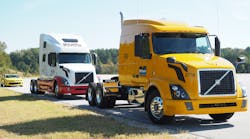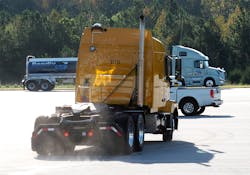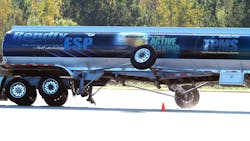Today, the goal at McKenzie Tank Lines is the Holy Grail: zero avoidable collisions among its 275-tractor, 680-trailer fleet. But talk to Jim Kennedy, vice president of maintenance, and you’ll hear it’s a longstanding quest going back to its earliest days.
The Tallahassee, FL-based liquid and dry bulk hauler got its start back in 1944 transporting fuel, so it had an added need for safety and an interest in related technology that could help. “We have a corporate culture of being an early adopter of safety technologies from an early get-go,” explains Kennedy, whose own experience at the now third-generation family business spans more than 35 years.
That technology adoption included McKenzie trying out air disc brakes on its trucks in 1979, right at the beginning of those systems’ ultimately ill-fated first entry in the U.S. market. Disc brakes still needed to mature and improve, but the company added automatic slack adjusters in 1984, a decade before they were required for commercial air brake systems.
Jim Kennedy, VP of maintenance at McKenzie Tank Lines, is a strong proponent of advanced safety technology to assist drivers and reduce collisions to a minimum.
Other innovations McKenzie embraced followed a similarly forward-looking path, like going to GPS tracking in ‘96, LED safety lighting in ‘97 and antilock brakes the year after. But the company “really jumped in head-first,” Kennedy contends, at the turn of the millennium with forward-collision warning and automatic crash notification systems. With the latter, McKenzie found it could alert the back office if one of its trucks had a collision or rollover and assist emergency responders by informing them of the tank trailer’s cargo.
“In the event of a crash, typically, they are going to go into the scene very slow, very carefully,” Kennedy notes. “You can accelerate that many times with cargo information.”
Technological groundwork
That was all well before those kinds of technologies would become common among U.S. carriers’ trucks, and for many, they still aren’t. Kennedy remembers technological stepping stones, as it were, for the fleet in the early 2000s that today’s advanced safety systems are still incorporating. One example was mapping out problem roadway “zones” and sending warning messages to drivers when they were approaching potential hazards like a set of upcoming sharp curves.
And the efforts to reach penultimate safety at McKenzie continued. The fleet went standard with lane departure warning systems in 2005 and had a big year to follow, adopting electronic stability control, enhanced wide foundation brakes and critical event reporting in 2006.
“That was our first foray into taking data out of the vehicle to the back office to begin to assess driver behavior and performance,” Kennedy notes. Fast-forward through going standard with air disc brakes in 2011 on its trucks and using electronic vehicle inspection reports as of 2013, and today he adds that “the important piece” of all that data available from trucks is integration.
Data-driven active systems
“An event occurs today and we’re talking about identifying the type, unit ID, date/time stamp, ID of the driver, latitude, longitude, video of the event, Google map of the event area, and a 20-sec. ‘histogram’ showing 10 sec. before and 10 sec. after the event,” he says. The ability of the fleet to custom-tailor video event recording integrating many points of data—whether the brakes were applied, vehicle yaw, lane departure, over-speed, collision mitigation events and more—is helping change the safety game.
So are the latest advanced safety systems like Bendix Commercial Vehicles’ Wingman Fusion, he notes, which Volvo Trucks North America fully integrated last year with in-dash instrumentation and made available on certain truck models as Volvo Active Driver Assist, or VADA. The system folds together radar and data-ready video to identify obstacles and brake automatically if necessary to avoid a collision. Soon-to-be-mandated electronic stability control systems on trucks like Volvo Enhanced Stability Technology, which is also based on Bendix tech, can apply the brakes to avoid a rollover if the driver heads into a curve too fast or cuts too sharp a turn.
McKenzie brought one of its latest Volvo VNL day cabs to showcase active safety technologies at the Volvo Safety Symposium last fall. It and others similarly outfitted performed dramatically and as advertised, applying the brakes to keep the tractors from hitting vehicles in their path or to prevent dangerous maneuvers.
Within reach
Fleets need to justify the costs of such systems. “Where we feel the real proof is,” according to Kennedy, is in the numbers, as in numbers of rollovers and collisions where a McKenzie truck rear-ends a vehicle ahead.
Back in 2000, “we were averaging 10 collisions a year” of those two varieties, he explains, and the company has been whittling away at that total ever since. It hasn’t quite been an even progression, with some ups and downs. In 2003, McKenzie had 2 rollovers and 10 rear-enders across its fleet; in 2007 it was 4 and 8, respectively; in 2012 it was 0 and 5; and for 2015 it was 0 and 1.
At the end of October 2016, the goal was in sight. The company had experienced none of either collision type for the year. But then suddenly, just like that, came disappointment. “We incurred one rear-end event in slow, start-stop, bumper-to-bumper traffic,” Kennedy tells Fleet Owner.
That backed-up traffic situation crash looked like it would be all, and then three days before the end of the year, one of its trucks had a rollover. “There are times where no safety system will overcome physics,” he notes. It raises the critical point that it’s not only these advanced technology systems pushing safety forward, it’s driver skill and behavior, fleets’ best practices in operations, and maybe just the luck of the draw on a given day.
In a tone-setting statement on its website, company President and CEO James Shaeffer alludes to this, noting that McKenzie drivers “are known for their skill throughout the industry and garner respect from their peers and customers alike” and staff are “constantly pushing ourselves to innovate and improve.” He also points to the company’s proactive adoption of cutting-edge safety features on its trucks: “We prioritize safety, pioneering new uses of accident avoidance technology.”
While it’s a tough break to have a spoiler rollover three days before the end of the year, at least it didn’t ruin McKenzie’s chances for a clean ‘17. Quips Kennedy: “There’s always next year!”
And the battle for zero continues.







